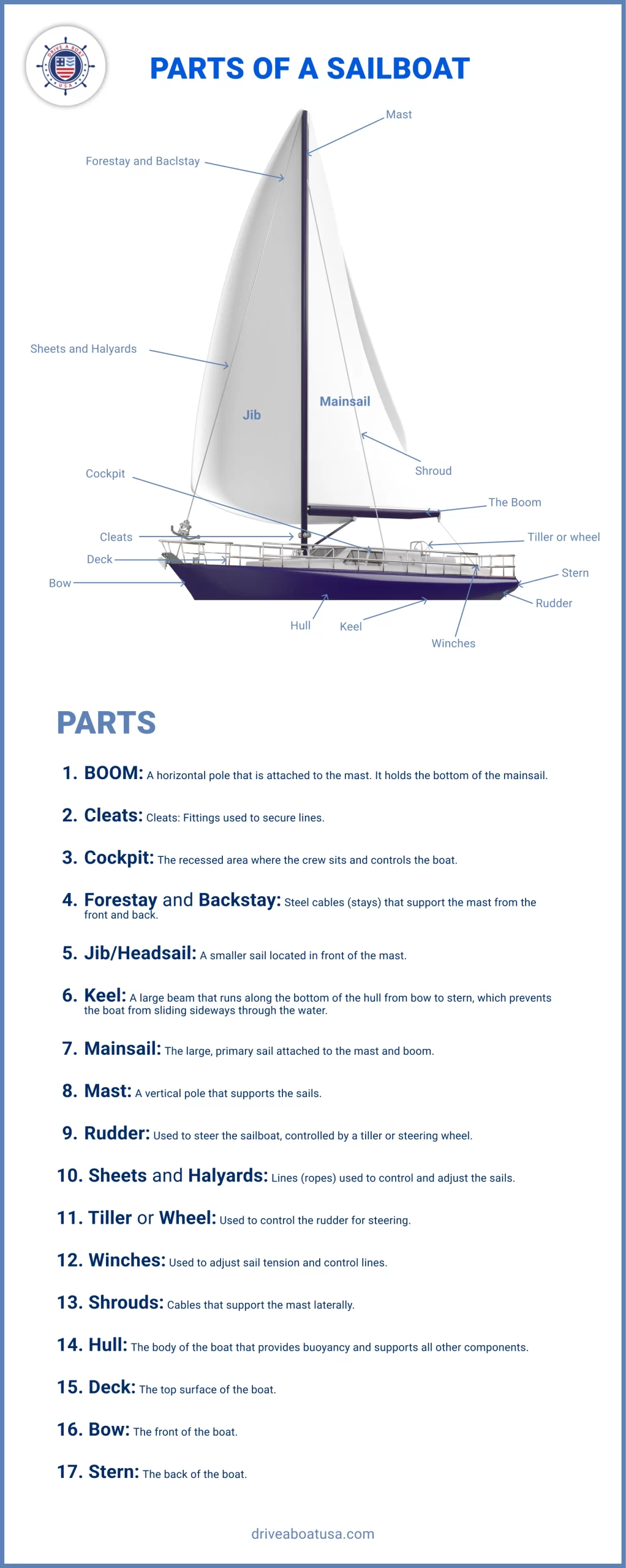Parts of a Sailboat & Sailing Terminology
A sailboat consists of several key components that work together to harness wind power and navigate through water. Anyone learning to sail or interested in the mechanics of sailboats should know what these parts are called and what they do.
Main parts of a sailboat
While not all sailboats have exactly the same structure, there are a few features that are found on almost every sailboat:
- Boom: A horizontal pole that is attached to the mast. It holds the bottom of the mainsail.
- Cleats: Fittings used to secure lines.
- Cockpit: The recessed area where the crew sits and controls the boat.
- Forestay and Backstay: Steel cables (stays) that support the mast from the front and back.
- Halyard: A line used to raise sails.
- Jib/Headsail: A smaller sail located in front of the mast.
- Keel: A large beam that runs along the bottom of the hull from bow to stern, which prevents the boat from sliding sideways through the water.
- Mainsail: The large, primary sail attached to the mast and boom.
- Mast: A vertical pole that supports the sails.
- Rudder: Used to steer the sailboat, controlled by a tiller or steering wheel.
- Sheets and Halyards: Lines (ropes) used to control and adjust the sails.
- Tiller or Wheel: Used to control the rudder for steering.
- Outhauls: Control the shape of the sail’s foot
- Vangs: Control the vertical angle of the boom
- Winches: Used to adjust sail tension and control lines.
- Shrouds: Cables that support the mast laterally.
- Rig: The arrangement of masts, sails, and supporting rigging that propels the vessel. This refers to standing rigging (the fixed rigging that supports the mast) and running rigging (the adjustable rigging used to control the sails).
Types of rig
The choice of rig depends on factors such as the size of the boat, intended use, and sailing conditions. Each rig configuration has its own advantages in terms of performance, ease of handling, and versatility.
- Sloop: Single mast with a mainsail and one headsail, the most common modern rig
- Cutter: Similar to a sloop but with two headsails
- Ketch: Two masts, with the shorter mast (mizzen) forward of the rudder post
- Yawl: Two masts, with the shorter mast aft of the rudder post
- Schooner: Two or more masts, with the shorter mast forward
- Catboat: Single mast stepped far forward with one sail
All parts of a sailboat work together to allow the sailboat to harness wind power, maintain stability, and navigate through water efficiently.
Parts common to all boats
Sailboats also share several parts that are common to all boats:
- Hull: The body of the boat that provides buoyancy and supports all other components.
- Deck: The top surface of the boat.
- Bow: The front of the boat.
- Stern: The back of the boat.
Sailing terminology
Sailing terms are fundamental to communication while on board a sailing vessel, and are used frequently to describe parts of the boat, sailing maneuvers, and wind directions. Anyone learning to sail or participating in sailing activities should understand what these terms mean before they start.
- Port: The left side of the boat (facing forward from within the boat).
- Starboard: The right side of the boat (facing forward from within the boat).
- Aft: Towards the back (stern) of the boat.
- Windward: The direction from which the wind is blowing.
- Leeward: The direction opposite to windward.
- Tacking: Turning the bow of the boat through the wind to change direction.
- Jibing: Turning the stern of the boat through the wind to change direction.
Drive A Boat USA boating safety course for sailors
There’s plenty to learn about when it comes to taking to the water in a sailboat! Find out everything you need to know about navigation lights, marine distress signals, PFD regulations, and more with a state-specific safe boating course from Drive A Boat USA!
Remember, you need a boating license to take to the water legally across the United States. Boaters in New York, California and Florida can earn their NASBLA and U.S. Coast Guard approved license online today from Drive A Boat USA!


